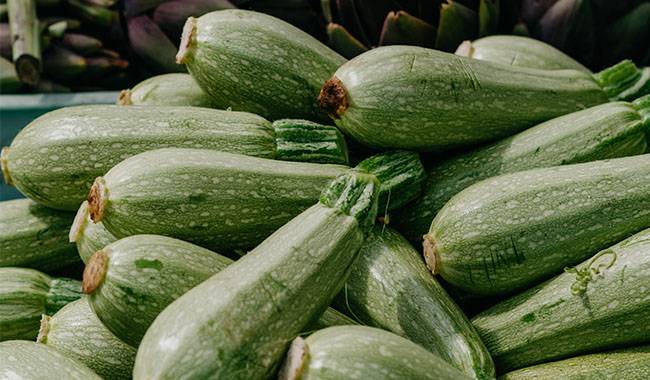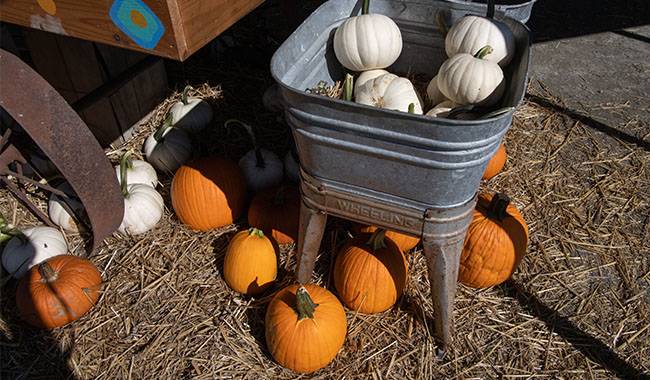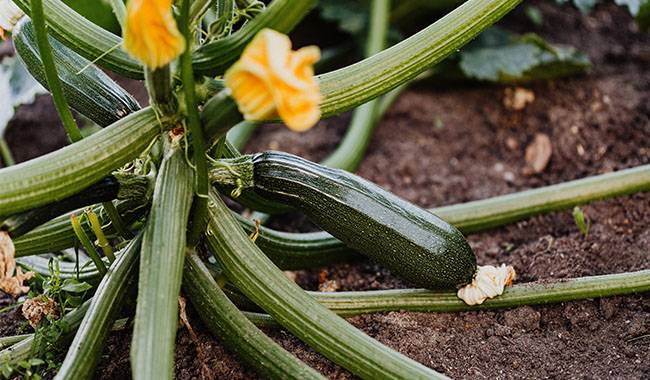
Although Zucchini and Pumpkin, like Pumpkin, belong to the Cucurbita family, they have many common, critical, and different storage conditions.
Zucchini and Pumpkin can be stored together if the vegetables are intact, undamaged, show no signs of decay, and are collected in a timely manner: they do not interfere with each other during storage, and there is no risk of disease transmission from Pumpkin to Zucchini, and vice versa.
However, it has been noted that Pumpkin is usually stored for much longer than Zucchini, so it is important to take this into account when storing the two crops together and to check the storage site at least every few weeks because if Zucchini starts to rot, the rot is likely to spread to Pumpkin.
Furthermore, it is a known fact that Pumpkin can be stored at much higher temperatures than Zucchini.
Of course, the long-term preservation of Pumpkin and Zucchini can be ensured if harvesting techniques, storage preparation, and storage conditions specific to the fruit of these crops are correctly observed.
It is important, do not overstore fruits and try to use them for food as soon as possible. the longer Pumpkin and Zucchini are stored, the rougher they become, lose some of their nutrients and at any moment they can start to spoil, so your efforts are simply wasted, do not forget this.
So let’s start with how to properly store Zucchini at home and then talk about Pumpkin.
HARVESTING ZUCCHINI FOR STORAGE
As we have already pointed out, the key to long-term and comprehensive storage of Zucchini is timely and proper harvesting. Therefore, with regard to Zucchini, it is necessary to harvest them (even small ones) before the onset of frost.
If frost is encountered when harvesting Zucchini, then the whole batch of Zucchini will deteriorate and they will not be suitable for storage. In the first days after storage, Zucchini caught by frost may start to rot and it is impossible to stop this process.
Keep in mind that the best Zucchini will be stored in those Zucchini whose skin is quite thick and if you tap on it you will hear a dull sound. The seeds should not be fully developed (technical maturity) and the size of the Zucchini should be medium.
The surface of the Zucchini should not be damaged, and fruits with defects in development should be excluded from the batches intended for storage at home. Pay attention to the “pattern” on the skin: based on the description of the variety, you will understand whether this specimen is ready for picking.
Do not forget that during storage, Zucchini may ripen, and once this happens, its structure will become loose. Do not be surprised that after cutting open the Zucchini (removing it from the simple storage), the seeds inside will germinate – this is not uncommon.
When putting the vegetable into storage, it should be cut so that a considerable part of the stem remains – 2.3-2.7inch (6-7 cm) long. The cut should be clear and precise, and the fruit should not be torn off by literally twisting the stalk: such fruit may not be stored for long periods of time.
The uniform cut and considerable length of the stalk provide good protection against the penetration of microorganisms that can lead to internal decay. In addition, the stalk is a good indicator of the overall condition of the fruit: if it is healthy after a certain storage period, then the fruit is probably healthy as well.
Negative changes in the stem indicate that the fruit is no longer healthy either. In cases where the stem has started to rot, it is best to remove the fruit for its intended purpose; leaving it in storage is a big risk.
To avoid this, be sure to pick Zucchini in dry, sunny weather and to do so carefully without damaging the skin.
Zucchini to be stored should not be washed, otherwise, they will start to rot. To get rid of dust and dirt, you only need to wipe them with a soft, dry cloth.
Damp vegetables should also not be put in storage, they should be dried first in a ventilated place. This will only take a few hours and they should be arranged in rows, never stacked on top of each other.
BASIC RULES FOR STORING ZUCCHINI
In addition to the aforementioned subtleties, the first rule is the correct selection of the Zucchini variety. For example, medium and late maturing Zucchini varieties (50 days and above) are best stored. Thus, very good results have been achieved in storing show varieties.
High-quality Zucchini varieties (50-60 days to maturity, cylindrical fruit, light green color, juicy flesh, good taste quality, good storage), common Zucchini varieties (50 days to maturity, small dots in the pattern.
The fruit itself is light green in color, with fine flesh and good storage) and the yellow fruit variety (record in terms of storage time, with 50-60 days to maturity, cylindrical fruit with a smooth surface, orange web on a yellow background, fine flesh, and pleasant taste).
However, despite the variety, even those fruits with the longest shelf life are best stored no longer than the beginning of March and consumed before this date.
Important note: When processing Zucchini after storage, be sure to remove the seeds and a small part of the pulp surrounding the seeds, as the seeds are bitter during storage and may also impart a bitter taste to the pulp where the seeds are located.
OPTIONS FOR STORING ZUCCHINI AT HOME
Zucchini should preferably be stored at 80% to 85% humidity, at a temperature of no more than 41°F (5°C) and no lower than freezing. If the temperature is very high, the storage period will be reduced to a minimum (the Zucchini will simply rot). You should not store Zucchini in an absolutely dark room, they should be kept in an unventilated area. However, stale air is also bad for them, and the room should be ventilated regularly, at least every two days.
An important condition for the long-term storage of Zucchini is that they should not come into contact with each other. Zucchini should not be stored next to other fruits and vegetables, except Pumpkin.
Usually, at home, Zucchini are stored in the basement or, in the case of apartments, on the balcony, which is regularly ventilated if it is heated, and conversely, if the balcony is not heated, the Zucchini is insulated, covered with a warm blanket and placed in wooden boxes decorated with Styrofoam.
You can try to keep Zucchini in the pantry, lay them on pre-built shelves there or hang them like cabbages, but only put each in a separate compartment (for example, from under the onions, you can even use the residual onion shells, which act as a preservative).
In inboxes on the balcony, Zucchini can be stored in dry sawdust or river sand, but for this purpose should not be placed, but vertically, so that the stems “look” up. At the bottom of the box, it is best to place straw or sawdust, in a layer of a few inches.
If it is cold on the balcony, in addition to covering the box with Zucchini on top with a blanket, you can wrap it in kraft paper, ordinary newspaper, or any strip of cloth before placing it in the box.
If you can keep the balcony or cellar at a lower positive temperature and have boxes available, stand the Zucchini up (so they don’t touch each other) and put kraft paper or plain corrugated cardboard between them.
Zucchini can also be stored as semi-finished products if there is absolutely no storage space and the right conditions cannot be guaranteed. To do this, they can be cut into rings or cubes and then dried, wilted, or, preferably, even frozen.
Important note: Do not try to store whole Zucchini in the refrigerator, they will not last more than 12 to 15 days there and will quickly start to rot.
HARVESTING PUMPKIN FOR STORAGE
Pumpkin is a wonderful and unique vegetable that many of us underestimate. It basically contains everything that the human body needs. Among other things, it feels great when grown in different types of soil, sometimes even slightly waterlogged, in absolutely different climate zones. pumpkin can come in absolutely different sizes and shapes – from a giant pumpkin that one cannot lift to the tiniest pumpkin.
Let’s move on to storage – as in the case of Zucchini, the key to the successful storage of Pumpkin is timely harvesting and proper conditions for further maintenance. How do you know it’s time to harvest Pumpkin?
Quite simply, according to the stem: if it has started to dry out and change color from green to gray, then it’s time to remove the Pumpkin from the ground and put it in storage.
Important! Do not, under any circumstances, let the stalk of the Pumpkin tear from the fruit. This will significantly reduce the storage time of this valuable fruit.
To properly harvest a Pumpkin, you must lift it slightly off the ground to loosen the stems and (as with Zucchini) cut the stems to 2-2.3inch (5-6cm) long, rather than tearing them off.
Pumpkin needs to be dry: its surface should be free of even a hint of moisture. The slightest particles of moisture that you overlook can later become foci of rot and mold that develop quite actively during storage.
If Pumpkin is stored dry, undamaged, harvested on time, and with its stalk intact, it can easily last until a new harvest.
STORAGE CONDITIONS FOR PUMPKIN AT HOME

It’s good to know that Pumpkin can be stored in conditions that are comfortable for you and me: i.e., 80-85% humidity and a high temperature not exceeding 71°F (22°C). The main thing is that in the room where Pumpkin is stored, the temperature does not fall below 30-40°F heat and does not exceed 32°F (0°C) towards frost.
The second important condition is to try to provide a constant temperature for the Pumpkin that does not fluctuate dramatically. For example, put it in a storage room at home, or if we are talking about an apartment, on a heated balcony.
Pumpkin can be stored uncovered, covered (in the same sack), in bulk (stacked in neat pyramids), in boxes or cartons that fit Pumpkin’s size.
Pumpkin is fine if it is reliably protected from sunlight and is stored not only directly, but in general, any, in the dark.
Check the safety of Pumpkin approximately once a week during storage. If the fruit begins to rot, remove it immediately and send it for processing, carefully cutting out the healthy tissue and removing the rotten seat.
If you have Pumpkin, make sure the air in the storage room is moist; it should not be too dry. This can cause them to dry out. If the humidity drops below 80%, you can spray the air with a sprayer or move the Pumpkin to a humid room, but preferably at the same temperature or with a minimal difference from the original storage location.
As with Zucchini, if you do not have a place to store the Pumpkin, you can prepare a half-finished Pumpkin. in order to do this, you should first carefully wash the Pumpkin, then peel it, cut it into two, three or four pieces, making sure that the seeds are removed along with the peeled pulp, and wrap it in a tightly sealed package with plastic wrap. After that, the Pumpkin should be placed in the freezer of an ordinary household refrigerator. Under these conditions, Pumpkin will last quite a long time and is suitable for many kinds of processing (except for processing into juice).
By the way, Pumpkin seeds are very useful for the stomach and intestines after roasting and contain a lot of vitamins. If you don’t want to roast them, you can simply put them in any metal container on a radiator for a few days, during which time they will dry out and can be eaten like roasted meat.
Important: You should not overcook Pumpkin seeds, because then you will kill most of the useful properties of the seeds. Only 1-2 minutes on a red-hot skillet should be enough, no more.
That’s all we wanted to tell you about storing Zucchini and Pumpkin. If you have your own personal storage tips for these vegetables, then share them in the comments. We think it would be helpful for everyone.




